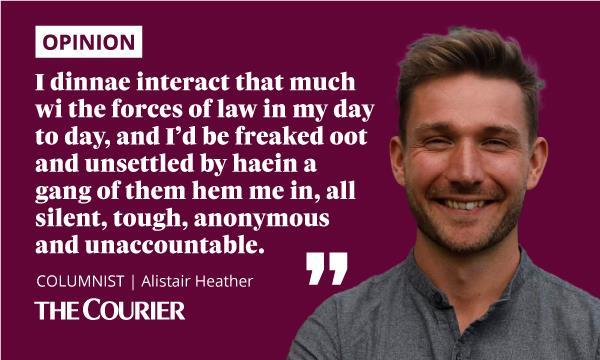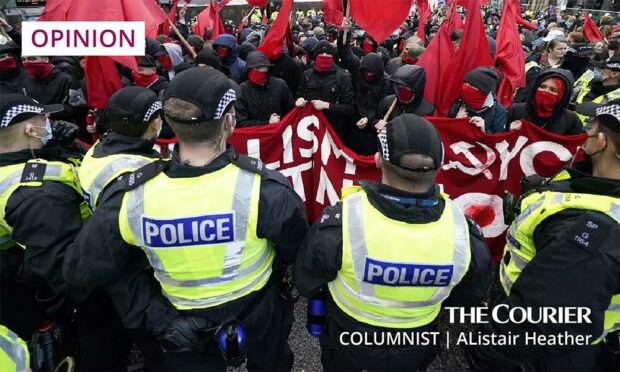I dinnae hate the polis. So if you’re after an article comparing the local bobby with Franco’s footsoldiers, this isnae it.
But the scenes doon at COP26 made me pretty uncomfortable, and made some of us ask “what are the polis actually for these days?”
There were a couple of specific incidents.
A wall of thuggish, anonymous looking cops in bright yellow gear, face masks and caps surrounded a wee bourach of teenagers who’d been on the march.
They sealed them in, and wouldn’t let them leave. They gave no reason for their punishment.

The other uneasy sight was the vast number of polis that fortified the Scottish Power building. Wearing enough hi vis jaickets to give marchers a sun tan off the reflected rays.
This was a peaceful march, so why had these public servants turned up in numbers enough to set a Napoleonic Army quaking in its shoes?
To wrestle with this tangled issue, I spoke to two people about some of the social media posts that came out of it.
One, a lawyer acting as a legal observer on the COP26 marches, making sure everyone acted according to the law.
The other, a police officer who deals with the public every day.
Tweet one: COP26 police V youthful improv
We began with this tweet from a political correspondent. It shows a mob of red-flag waving teens surrounded by police.
They are being prevented from moving and are responding by chanting “if you hate the f***in polis raise yer flag.”
First real police presence I’ve seen so far at #COP26 is the ring of steel around this group from the YCL. pic.twitter.com/ACwRNLvAyr
— John Johnston (@johnjohnstonmi) November 6, 2021
My lawyer contact was raging, saying the heavy police presence has been smothering the energy out of the COP26 protests and marches.
“In Scotland the police fear what they can’t control,” they told me. “They saw Communists and it freaked them out.”
The police contact did not entirely disagree.
As much as the polis have that wider desire to maintain public order, it is trumped by the need to protest
Police don’t like groups acting independently, they told me.
All the marches and routes would have been agreed well in advance, and the police would have mapped it all out and prepared diligently.
Any youthful improv would be smoored at source.
I cannae approve of that. As much as the polis have that wider desire to maintain public order, it is trumped by the need to protest, and to do so freely and without molestation by the state.
Especially when it matters so much, as the climate disaster does.
Tweet two: COP26 police kettling complaints
Our second post came from a Labour MSP for North-East Scotland.
It shows young marchers being sectioned off and trapped in by a police ring of steel – with apparently no provocation.
Yesterday trade unionists, climate activists and civil society marched as one to demand change.
Part of the workers' bloc was kettled and prevented from rejoining the march.
We will only win by standing together. So an attack on one is an attack on all. Solidarity. #COP26GDA pic.twitter.com/7AU4IDzol0
— Mercedes Villalba MSP (@LabourMercedes) November 7, 2021
Our lawyer friend is under no illusions: this is incorrect use of the technique known as kettling.
“The supreme court justified kettling as being an acceptable infringement of our human rights, in cases where the safety of others might be compromised,” they said.
“I’d argue that in Glasgow there was absolutely no risk from the young people that were kettled. The police used that tactic as a way to break up and stifle protest.”
No one likes seeing great big yellow walls of police officers around marches… People will obviously think the police have overreacted
Our friendly neighbourhood police correspondent agrees the optics are negative, but insists it was almost certainly justified.
“I seen that on social media at the time and thought ‘we’re going to get a kicking here’,” they said.
“No one likes seeing great big yellow walls of police officers around marches or whatever.
“People will obviously think that the police have overreacted, but the tactic won’t have been used for no reason… We don’t know what intelligence has been received.”
Tweet three: Is this Glasgow or Belarus?
Our final post is this: a little walking tour group being encircled by police
Learning about polluters is a threat, apparently. Informative walking tour encircled by police. Welcome to #cop26 @COP26_Coalition @Ggow_COP pic.twitter.com/y2SxxlWB0a
— Climate Camp Scotland (@ScotClimateCamp) November 4, 2021
This one makes me particularly uncomfortable.
Our polis defended the level of force. “Heavy handed tactics is what you see in Belarus, with gas canisters and batons,” they said. “There’s a big difference.
“The police are here to keep people safe. We’re here to prevent crime.”
But it seems heavy handed to me.
I dinnae interact that much wi the forces of law in my day to day, and I’d be freaked oot and unsettled by haein a gang of them hem me in, all silent, tough, anonymous and unaccountable.
Our lawyer agrees. “The police are so powerful, and they can act with relative impunity in a country with so many poor people like Scotland.”
Better to focus on investigating serious violent and sexual crimes, they suggest. Leave social issues well alone.
Which brings me back to that question.
I personally think we’ve evolved way past thinking that criminals and crime can be cured by a militaristic state force like the police.
There remains a place for good-hearted public servants willing to risk their wellbeing to defend those that need it, and they have my admiration.
But the roots of crime are often traced to poverty. We should look to tackle those root issues if we want to see long-term reductions in serious crime.
I don’t finish here with an answer but a question to you, dear reader.
What do you think the Scottish police are actually for?
